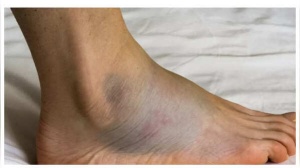Maria Palen, a 31-year-old chemical engineer from California, embodied peak fitness. With a vibrant Instagram presence boasting over 20,000 followers, she inspired many with her plant-based diet and rigorous exercise routine. However, her journey took an unexpected turn when she was diagnosed with babesiosis, a parasitic infection transmitted through tick bites. This diagnosis ultimately led to paralysis from the waist down by late 2024.

Image credit: Instagram/planthlete_maria
Palen’s story highlights the potential for hidden health threats, even in seemingly healthy individuals, and emphasizes the need for vigilance against tick-borne illnesses.
Initially, Palen experienced mild symptoms: inflammation, joint discomfort, and thumb pain. Attributing these to lifestyle factors, she intensified her healthy eating and exercise habits. Unfortunately, her condition deteriorated.
By March 2024, she was largely confined to bed, struggling with simple tasks. Eventually, a functional medicine specialist identified babesiosis, a disease caused by Babesia parasites infecting red blood cells. Unlike Lyme disease, babesiosis often goes unnoticed because its early symptoms resemble the flu or general fatigue. The Centers for Disease Control and Prevention (CDC) reports a doubling of babesiosis cases in the last decade, from 1,000 in 2011 to approximately 2,500 annually today.
Palen suspects the tick bite occurred years prior, possibly during an outdoor hike. The infection gradually progressed, eventually impacting her nervous system and leading to paralysis.
Tick bites are often painless and easily overlooked. The insidious nature of some tick-borne infections lies in their ability to remain dormant for extended periods. Palen's case underscores the limited awareness surrounding lesser-known diseases like babesiosis.
Ticks are most prevalent during warmer months, thriving in grassy and wooded environments. A mild winter in 2024 contributed to a surge in tick populations in the US, increasing the risk of transmission of rare infections, according to researchers at the University of California, Riverside.
The microbes responsible for babesiosis (Babesia microti and B. duncani) are difficult to detect because they reside within red blood cells. Research on the genome of B. duncani reveals similarities to the malaria parasite, explaining symptoms such as fever, chills, and muscle aches.

Pic courtesy: iStock
Despite her challenges, Maria Palen demonstrates resilience, undergoing extensive therapy with hope for recovery. Her experience highlights the significance of early detection in combating tick-borne illnesses.
While doctors commonly test for Lyme disease, babesiosis may not be immediately considered. Given the potential for co-infection, it’s crucial for healthcare providers to adopt a comprehensive approach. Individuals should be vigilant in tracking unexplained changes in energy levels, muscle strength, or chronic pain, especially after outdoor activities.
The risk extends beyond hiking and camping. Gardening in overgrown areas or walking in wooded areas can also expose individuals to ticks, particularly without protective clothing or repellents.
Preventing tick bites requires more than just basic measures:
[This article is intended for informational purposes only and is not a substitute for professional medical advice. For any symptoms or health concerns, please consult a licensed healthcare provider]
Newer articles
Older articles
 5 Overlooked Warning Signs of Colon Cancer: Early Detection Saves Lives
5 Overlooked Warning Signs of Colon Cancer: Early Detection Saves Lives
 Shukla's ISS Arrival Heralds New Era for Indian Space Exploration; Gaganyaan Mission Looms
Shukla's ISS Arrival Heralds New Era for Indian Space Exploration; Gaganyaan Mission Looms
 Vijay Sethupathi Apologizes Amid Controversy Over Son Surya's Film 'Phoenix'; Thalapathy Vijay's Support Revealed
Vijay Sethupathi Apologizes Amid Controversy Over Son Surya's Film 'Phoenix'; Thalapathy Vijay's Support Revealed
 Android Security Alert: Government Warns of Critical Flaws Exposing User Data
Android Security Alert: Government Warns of Critical Flaws Exposing User Data
 Ashada Gupt Navratri 2025: Dates, Significance, and How to Observe This Hidden Festival
Ashada Gupt Navratri 2025: Dates, Significance, and How to Observe This Hidden Festival
 Smith Eyes Grenada Test Return After Injury Layoff
Smith Eyes Grenada Test Return After Injury Layoff
 Skin Deep: 7 Warning Signs on Your Skin That Could Signal Heart Trouble
Skin Deep: 7 Warning Signs on Your Skin That Could Signal Heart Trouble
 Staying Hydrated May Significantly Lower Risk of Heart Failure, New Study Suggests
Staying Hydrated May Significantly Lower Risk of Heart Failure, New Study Suggests
 Moto G54 Price Slashed in India: Check Out the New, Lowered Costs
Moto G54 Price Slashed in India: Check Out the New, Lowered Costs
 Gambhir Sidelines Pant's Twin Tons After India's Test Loss, Emphasizes Team Performance
Gambhir Sidelines Pant's Twin Tons After India's Test Loss, Emphasizes Team Performance